By: Britney Mayorga
Introduction
According to the United States Census Bureau Atlanta, Georgia American Community Survey Demographic and Housing Estimates (2019), 4.3% of the total population of Atlanta (21,148 out of 488,800 individuals) identified as Hispanic or Latino. As you move out from the city of Atlanta along Buford Highway into the suburbs, the Hispanic or Latino population increases. In Chamblee, Georgia, a city fourteen miles from downtown Atlanta situated along the Buford Highway (About Chamblee, 2021), 37.4% of the total population (10,944 out of 29,232 individuals) identified as Hispanic or Latino (Chamblee, Georgia American Community Survey Demographic and Housing Estimates, 2019). Buford Highway is a 3-mile stretch in DeKalb County, Georgia that is known as Atlanta’s International Corridor because it “brings together more than 65 languages, cultures, cuisines, customs and traditions” through more than 1,000 immigrant-owned businesses (DeKalb Convention & Visitors Bureau, 2022). Along this corridor is Plaza Fiesta, a Kennedy Wilson Property shopping mall that opened in 2000 that is called “El Rinconcito de Nuestro Pueblo” (the little corner of our town) because it provides food, baked goods, candy, and events from Latin America to celebrate cultural heritage (About Us, 2022). The Mexican population represents the largest group of the Hispanic or Latino population in Atlanta, comprising close to 50% of the Hispanic or Latino population (9,880 out of 21,148). In Chamblee, 22.9% of the Hispanic or Latino population in Chamblee identify as Mexican. With this large Mexican population in Atlanta, I seek to see to examine the extent to which Mexico is represented in Plaza Fiesta through its linguistic landscape in terms of signs, products being sold, religious artifacts, and the structure of the building in order to understand how immigrants preserve their culture in the United States.
Research Design
To collect my data, I visited Plaza Fiesta with my mother, who was born and raised in Mexico. Throughout our visit, she pointed out representations of Mexico that I did not notice during my first visit. I took photographs of murals, signs, products, and displays that my mother and I believe are representative of Mexico based on their colors, designs, cultural significance, and similarity to those seen in Mexico. I attempted to include representations that were specific to Mexico and were not representative of all of Latin America by ensuring that each photograph had a direct link to the culture in Mexico that was not seen elsewhere.
Results
I saw many representations of Mexico through the products, religious artifacts, signs, and the structure of the building.
Consumer Goods
In terms of products, I saw many artisanal dishes that were made of clay and had various patterns such as curving lines, flowers, leaves, the word Mexico, the logo of teams in the Mexican soccer league, characters from the Mexican lottery, and many bright colors. As seen in figure 1, there were also traditional Mexican handcrafted toys such as boleros and pirinolas (spinning tops) with the wood exposed and words written in green and red, the colors of the Mexican flag. In the same displays, there were also molcajetes, tortilladoras, and metate. Some of these products had the official “hecho en Mexico” (made in Mexico).
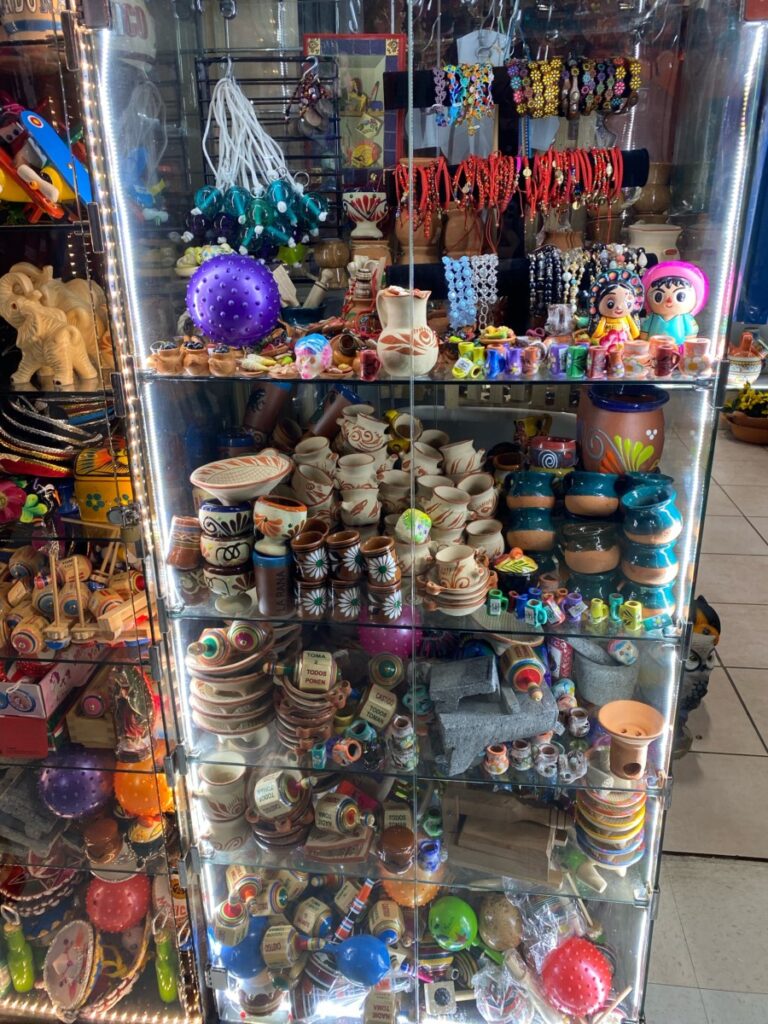
There were also keychains with the word Mexico, masks with the logos of the teams in the Mexican soccer league, hats with the Mexican eagle, and sombreros with “Viva Mexico” written in red and green. In terms of clothing, there were Mexican jerseys from different seasons and jerseys for the Mexican soccer league teams. There were also various dresses for traditional folkloric dances, ponchos with the Mexican flag, and sarapes. In terms of food products, we saw a lot of traditional Mexican candy that was imported from Mexico, chicharrones, herbal teas and spices, and fresh fruit. Other objects that caught my eye were decorations made from the leaves of corn (as is seen in figure 2), a keychain that looks like a can of the Mexican beer Corona that said “Corona Covid,” and a Mayan calendar.
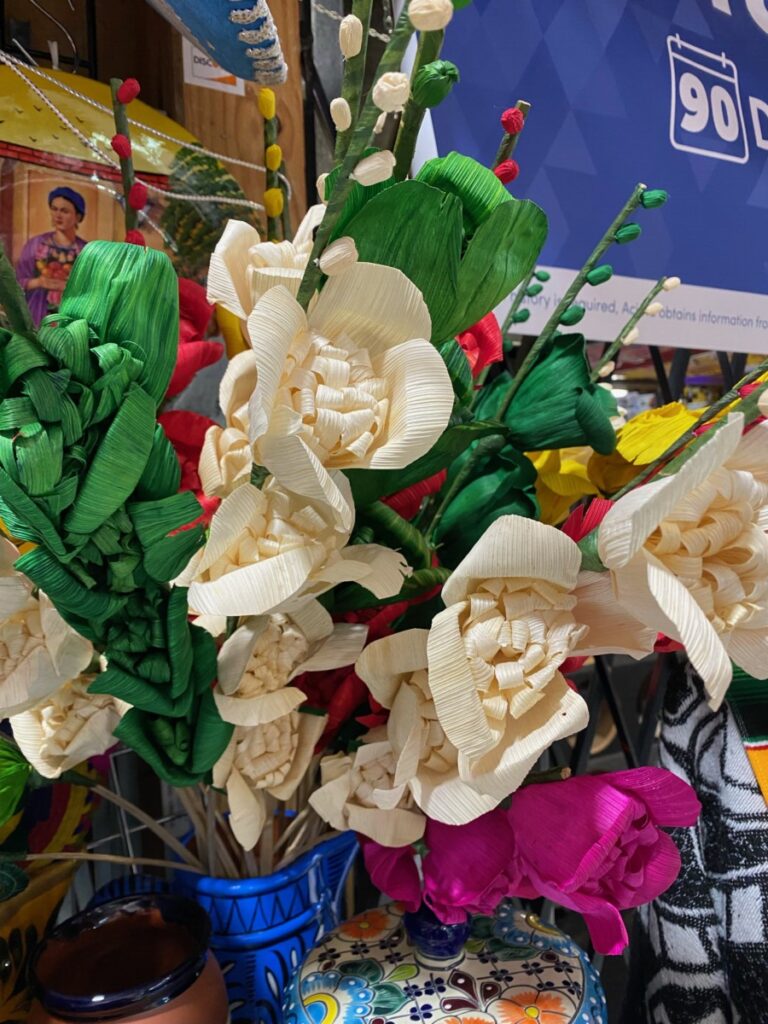
Religious Artifacts
In terms of religious artifacts, there were many stores that had many representations of the Nativity of Jesus, saints, and rosaries. However, the religious artifacts that are representative of Mexico specifically are those of Our Lady of Guadalupe. As is seen in figure 3, there were many statues of this Mexican patron saint targeted at little kids with round faces and cartoon-like eyes. Another religious artifact that is a representation of Mexico specifically is escapularios that had images of Jesus and Our Lady of Guadalupe. In one of the stores, there were religious artifacts on the same display as botanical products.
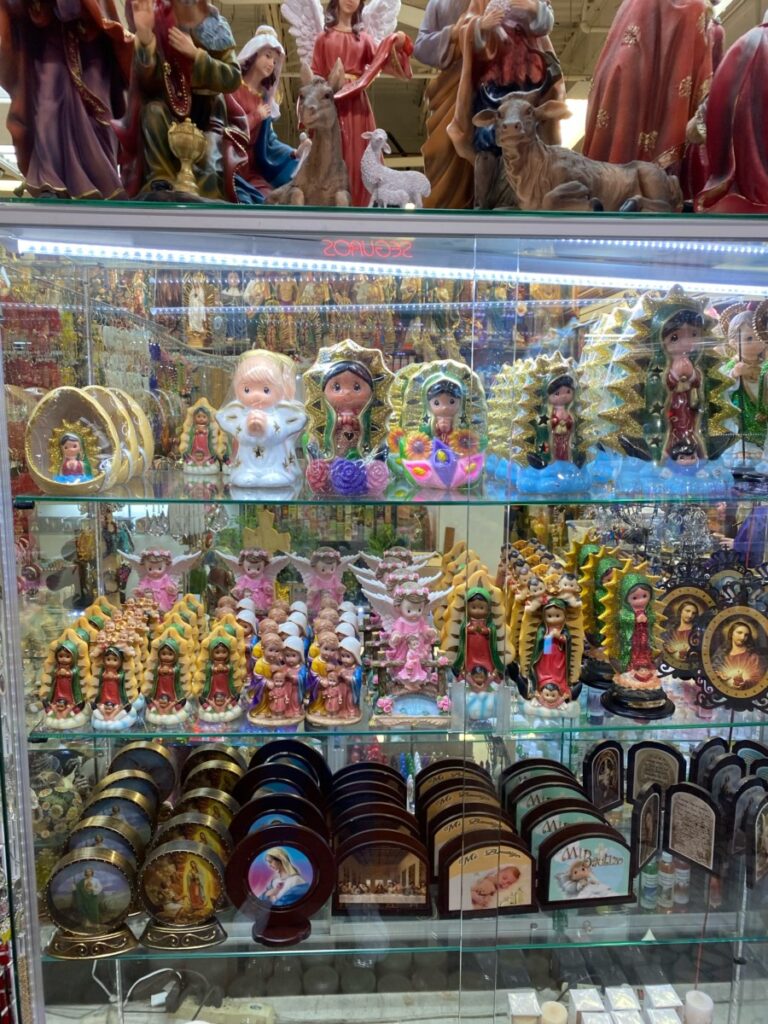
Signage
In terms of signs, I classified them as being representative of Mexico if they were in the colors of the Mexican flag (red, green, and white), contained Mexican states, or were representations of Mexican dishes. As is seen in figure 4, one of the botanical stores had Mexican colors of green, white, and red.
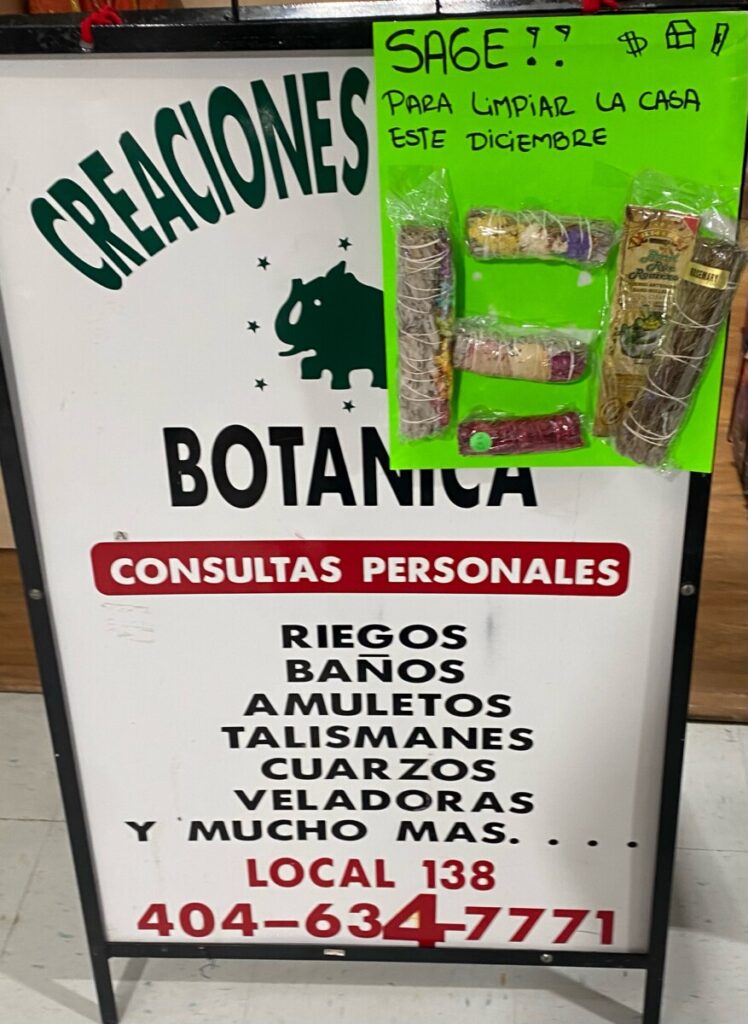
Another sign showed images of Mexican beers including Corona, Pacifico, Victoria, and Modelo. Another sign, figure 5, had the word Michoacan, a Mexican state, and contained images of Mexican dishes such as flautas and gorditas.
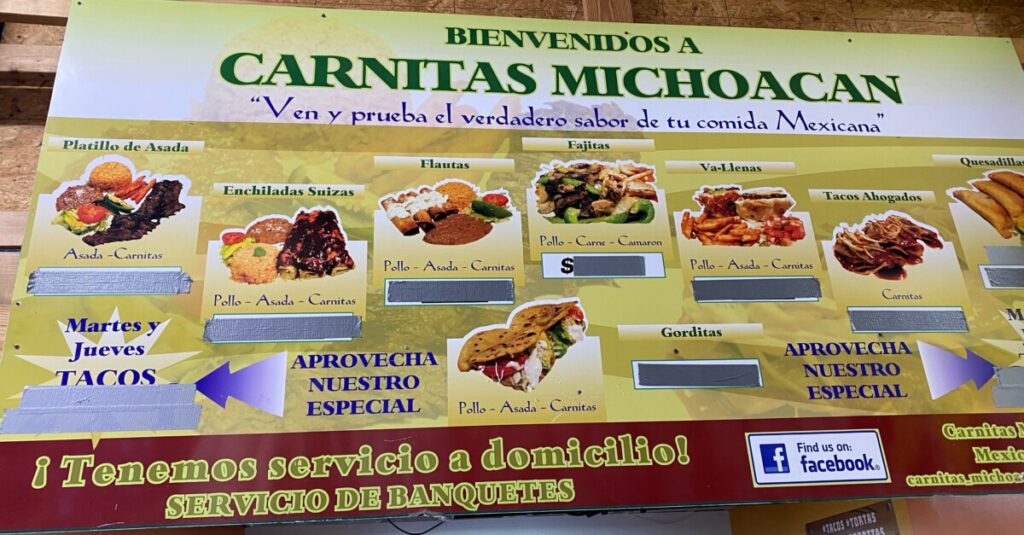
There were also signs for esquietes and the signs for Tortillas Guerrero had a red and green background. One of these signs contained the text “un pedacito de México” (a piece of Mexico). Another sign indicating that masks are recommended for the fully vaccinated and required for the unvaccinated was also in the Mexican colors. Another representation of Mexico in signs was through promotional posters for Mexican bands and groups that will be playing soon.
Structures
Lastly, Mexico was also represented in the structures outside of Plaza Fiesta. In one of the entrances, there is a mural (figure 6) of the Aztec god Quetzalcoatl and alebrijes with bright colored backgrounds including Mexican pink.

The benches outside Plaza Fiesta have the logos of Mexican states embedded in the bench including Aguas Calientes, Chiapas, Chihuahua, Guerrero, Morelos, Nuevo León, Oaxaca, Sinaloa, and Yucatan. Inside Plaza Fiesta, there are papel picado and other decorations in Mexican colors decorating the roofs.
Analysis and Discussion
From my results, I can see that Mexico is greatly represented in Plaza Fiesta through different media and all throughout the mall. Moreover, from this data, the representation of Mexico has a permanence and intentionality to it because a lot of its representations, such as on the benches and on the mural, are permanent and cannot be easily taken down or covered up. This profound and vast representation of Mexico can serve to preserve the culture and provide a sense of community in a foreign county.
Since Plaza Fiesta has a vast representation of Mexico, it attracts Mexicans and Mexican-Americans from Atlanta and even from surrounding states. One of my Mexican-American friends at Emory is from neighboring Alabama where her mother has a boutique for quinceanera dresses. She has said that her mothers’ clients often come into the store and compare the prices of the dresses to those in Plaza Fiesta, miles away from where they live. Being willing to travel many miles to buy a dress for a Mexican tradition at a low price, shows how well known Plaza Fiesta is among the Mexican community and how important and unique it is to purchase traditional products. Therefore, it appears that Plaza Fiesta serves as an oasis for Mexicans and Mexican-Americans, although further study into where customers come from and the reason they shop at Plaza Fiesta would need to confirm this.
Due to its vast representation of Mexico and its attraction to Mexicans and Mexican-Americans, Plaza Fiesta can also serve as a prime location to assess how Mexico is portrayed in Atlanta in terms of which images are the most prevalent. From my data, I found that Mexico is largely represented in this one mall through religious images, food, and indigenous products. Because of the influence of indigenous cultures on Mexican culture, specifically Aztec and Mayan culture, Plaza Fiesta would be a good location to analyze the portrayal of these cultures. In my short visits, I found a Mayan calendar; however, with more extensive research, the extent of indigenous culture portrayed could be explored.
Additionally, due to its vast representation of Mexico, Plaza Fiesta allows for an analysis of the degree to which Mexico is portrayed as a monolithic nation or if there is some recognition of the sixty-three nationally recognized native languages. In Mexico, in an effort to preserve its rich culture, the General Law of Linguistic Rights of the Indigenous Peoples was approved in 2003 by the Mexican Congress to make indigenous languages national languages that can be used for official documents (Čirjakm, 2020). Since Mexico itself is attempting to preserve its indigenous languages and recognize its cultural and linguistic diversity, analyzing how Mexico is represented in the United States in malls like Plaza Fiesta could provide insight into whether this diversity and variety is also being represented outside Mexico.
Through this linguistic landscape study, I was able to determine that Mexico is vastly represented in a mall in the United States, Plaza Fiesta, but there are a lot of other questions that could be answered to develop a deeper understanding of how Mexico is represented. Additionally, Plaza Fiesta is not the only shopping destination where Mexico is greatly represented with La Vaquita Flea Market, formerly known as Pendergrass Flea Market – La Vaquita, in North Georgia being open since 1992 (La Vaquita Flea Market | Linkedin, 2021). After Plaza Fiesta opened in 2000, two more similar shopping centers opened to the northeast of Plaza Fiesta in neighboring Gwinnett County, Santa Fe Mall in 2005 in Duluth, Georgia and Plaza de las Americas in 2016 in Lilburn, Georgia. The greater Atlanta area thus offers a rich landscape for examining and comparing representations of Mexico in commercial areas.
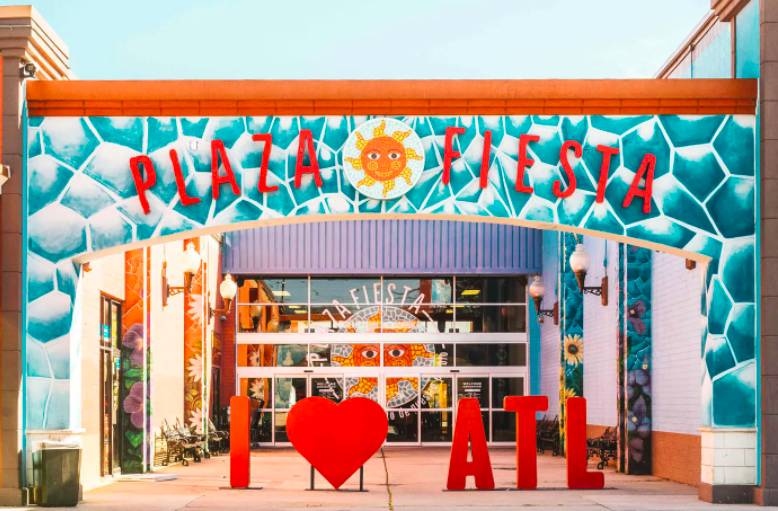
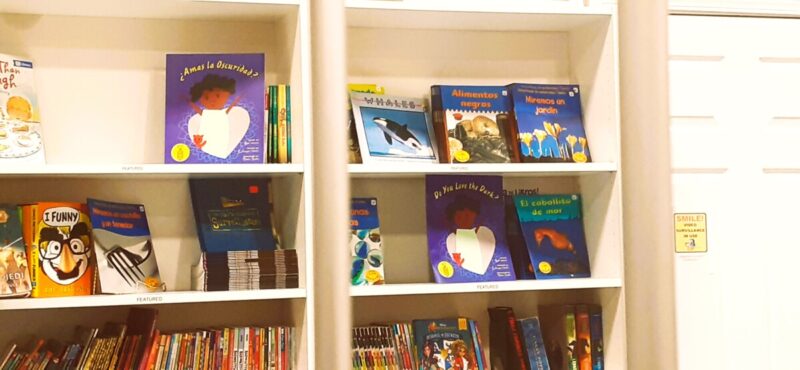



1 Comment
Add Yours →Your research does an amazing job at highlighting many specific products at Plaza Fiesta that represent Mexican culture that I certainly did not know about. I also never realized that so many aspects of Mexican culture are still represented by Aztec and Mayan roots. You do a great job not only identifying the symbols but explaining what they are and how they are significant. Great work!